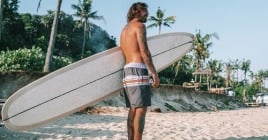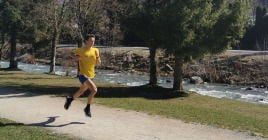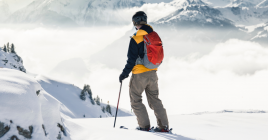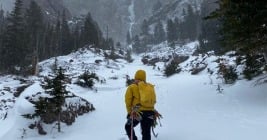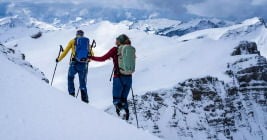What is a GR?
A GR is a long-distance hiking itinerary which corresponds to a route lasting several days or several weeks. It is marked by a red and white line. The national interest of a GR is to criss-cross a region or department(s) and to discover its cultural, historical and culinary secrets.
Among the most famous we know :
- The GR 20: crossing Corsica (180 kilometres in 16 stages and more than 10.000m of positive altitude difference) The GR 20 is famous all over the world for its beauty and its difficulty.
- The GR 10: it is a medium mountain route of 900 km, crossing the Pyrenees, between the Atlantic and the Mediterranean (50,000 metres of difference in altitude - 360 hours of walking and 55 days of hiking).
- the GR 65: It stretches from the Puy-en-Velay path to the Spanish border over more than 5500 kilometres. It passes through 4 main routes towards Santiago de Compostela, listed as a UNESCO World Heritage Site.
- The GR 11: It forms a 600 km loop around Paris and allows hikers to discover the richness of the natural areas surrounding the capital.
- The GR 5: Cross the Netherlands (Rotterdam), Belgium, Luxembourg, Switzerland and finish your route in the south of France (Nice) with 2600 kilometres of hiking.
- The GR 21 : It crosses Haute-Normandie, from Le Havre to Le Tréport over a distance of 171 kilometres. This long hike runs along the Albâtre Coast and then inland. The landscape alternates between limestone cliffs, ports, fields and forests and offers many remarkable viewpoints.
Hiking itineraries that require very precise preparation and good training!
A safe physical condition
Because of the distance covered, it is essential to prepare a minimum amount of time before embarking on the adventure.
Before your departure, don't hesitate to do long hikes in order to get used to them and thus multiply your chances of success. Take the opportunity to try your equipment at least once to avoid unpleasant surprises.
The equipment
The shoes
Opt for a pair of shoes in which you are comfortable and light enough. Avoid buying them at the last minute, it's better to wear them out before departure to break them to avoid blisters. Completed with a good pair of hiking socks, you shouldn't have a blister!
Discover our selection of hiking boots
The backpack
The backpack will be an extension of itself for the duration of the RG, so don't look at the savings on this expense.
The ideal, as for the shoes, is to try it on, and test it several times before going for long hours of walking with it on your back.
Opt for a bag adapted to your morphology but above all light and comfortable to carry with weight.
Pay attention to the bedding of your bag, because the bigger you get, the more likely you are to take unnecessary things that you will have to carry whatever it is you're carrying.
Discover our selection of Hiking / trekking bags
Also read how to choose the right hiking bag.
Prepare your RG in total autonomy
Doing RG in autonomy implies that you have to carry with you the necessary equipment to sleep, eat and live. In this case it will be important, even vital, to locate upstream the possible supply points.
The ideal weight should not exceed 18 to 20 kgs to be able to enjoy without suffering too much. This implies a very selective choice in your clothes and equipment and a rather hard training if you have a little more weight. The maximum recommended weight for a backpack is 20% of the wearer's weight.
Fill your bag in a balanced way so that you are less fatigued. To do this, place the heaviest objects in the middle of your back. They should be centred as much as possible (at the level of the spine), placed as close to the back as possible (not towards the outside of the backpack) and ideally under the shoulders and above the hips.
Composition of the Bag
For a few hours of walking or a day, the best thing to do is to take it with you:
- Sunglasses,
- A tube of sunscreen,
- A cap or a hat,
- Protective clothing against the rain,
- A sweater or jacket in polar fibres, thin or thick, depending on the season and the temperature,
- Walking sticks if possible crompressible in order to save space
- Running supplies (gingerbread, bars, dried fruit, marzipan...),
- Water, minimum 1.5 l,
- A survival blanket,
- A whistle,
For several days with accommodation, it is necessary to add to the equipment already mentioned above :
- a change of clothes and underwear,
- sandals or light shoes to relax in the evening,
- a poncho or raincoat,
- overpants,
- spare batteries for the headlamp,
- a "meat bag" or a fitted sheet,
- hats and gloves for morning or evening depending on the season,
- a toiletry kit: soap, detergent, toothpaste
- reading,
- racing supplies for several days,
- topographical maps.
- a folding knife,
- a first aid kit,
- a compass,
- binoculars or a camera,
- a cell phone,
- a headlamp (useful in case of a late departure in winter or a dark passage - such as an old disused tunnel for example or in a refuge).
- A pair of shoelaces.
For several days in autonomy, it is necessary to add to the equipment already mentioned above :
- the tent,
- the sleeping bag,
- the mattress,
- a lighter and matches away from moisture,
- solar charger
- the stove and its fuel,
- popote : the sponge and tea towel, but especially cutlery.
- the provisions,
- trash bags,
- Micropur or Hydroclonazone tablets
- wallet with cash, bank card, identity card and vital card.
Our latest tips
- Prepare your itinerary well: access to the starting point (train, car), distance, altitude, difficult passages, food and water supplies, bivouac / gîte / hut locations.
- Preparing meals well
- Why not do it with several people: it's more fun and above all safer. Helping each other can help you to surpass yourself and above all to re-motivate yourself.
- Test all your equipment on previous outings. Never leave with something you've never used before!
- Book the refuges in advance. Many can be booked online.
- Take good care of your water supply. Fill up your water bottles and cans at every opportunity. It is quite common to have to stay for several hours afterwards without any water.
- Take care of your feet: nail care, massage, cream in the evening at the stage are necessary to have a "tool" of walking in good condition and not to suffer.
- Take care of your sleep: a good night's sleep is the key to a good recovery to face the next day.
Also to be read Also to be read Going trekking


